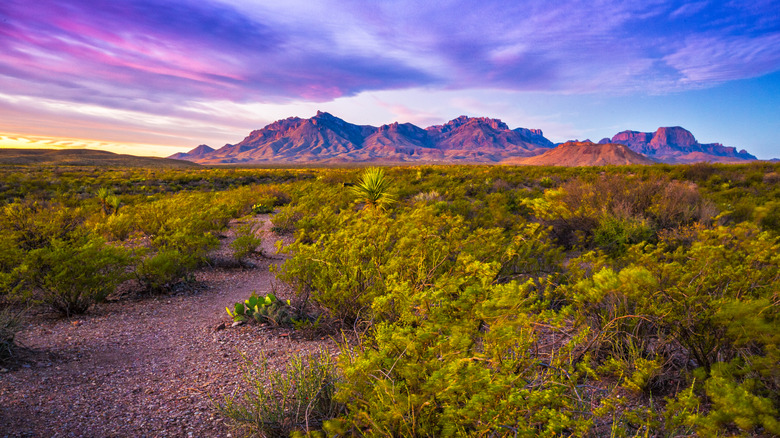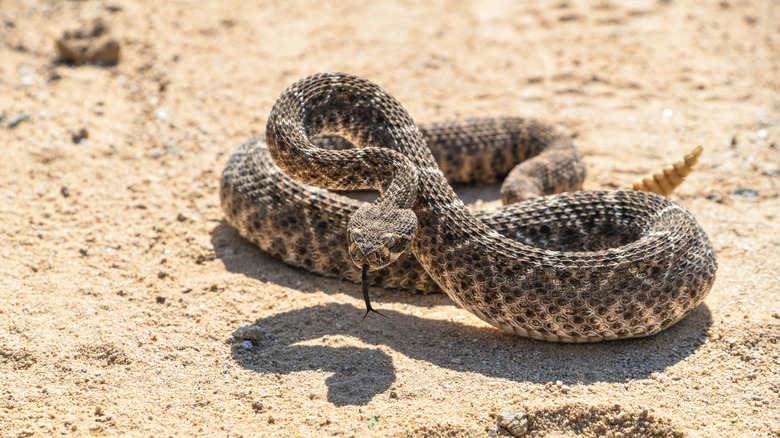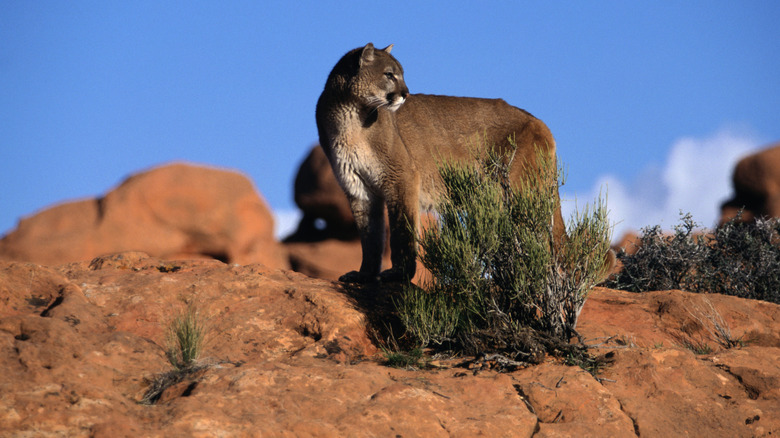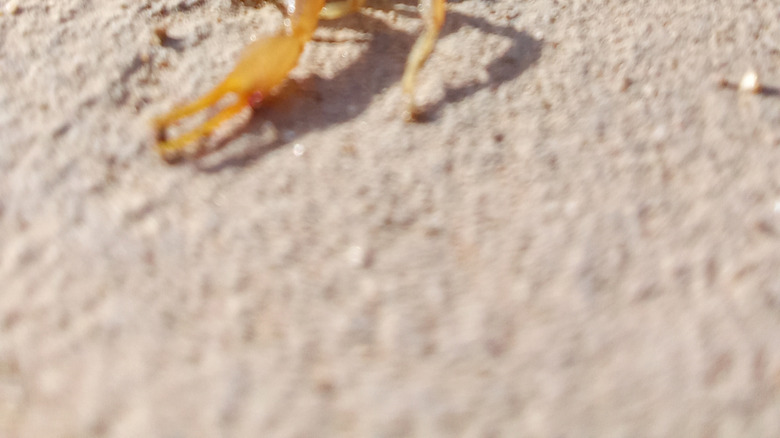5 Creatures To Beware Of When Adventuring In The Deserts Of Texas
We may receive a commission on purchases made from links.
There are only four major deserts throughout all of North America. The largest of those, the Chihuahuan Desert, covers more than 250,000 square miles, including the western quadrant of Texas. Within this region of the Lone Star State are some of its most rugged, yet popular outdoor recreation areas, including Big Bend National Park, one of the most dangerous parks in the U.S., and Guadalupe Mountains National Park, home to some of the country's most perilous hiking trails. Part of what makes adventuring in these areas so risky is the myriad of dangerous creatures found throughout the region.
While the popular image of deserts is that they are practically lifeless, nothing could be further from the truth. Deserts are full of plants and animals which have evolved to survive in the harsh conditions. According to the National Park Service, more than 170 species of reptiles and amphibians, along with over 130 species of mammals can be found in the Chihuahuan Desert. While the vast majority pose little to no threat to humans, there are a handful of creatures to beware of when adventuring in the deserts of Texas.
Be careful of hidden rattlesnakes
As is the case wherever they are found, rattlesnakes are a real danger for those adventuring in the deserts of Texas. After all, they are one of the most dangerous types of snakes in the world and they are very common in the West Texas desert. In fact, there are a half-dozen species of rattlesnakes found in the Texas portion of the Chihuahuan Desert: Western diamondback, black-tail, rock, Mohave, prairie, and massasauga.
Although rattlesnakes are generally not considered to be aggressive towards people, they can become so if they feel threatened, scared, or trapped. Given that it is entirely possible to inadvertently frighten a rattlesnake while hiking or rock climbing, it is a good idea to know what to do if you encounter a rattlesnake before you embark on an adventure in the West Texas desert. As a rule of thumb, the best way to stay safe in rattlesnake territory is by being aware of your surroundings and not placing your hands and feet anywhere without first scanning for snakes. If a rattlesnake is sighted, it is best to give them plenty of room.
Unfortunately, even taking such precautions is not guaranteed against encounters with these reptiles. So, it is also important to know the steps to take if you get bitten by a venomous snake. As an extra precaution, it is a good idea to wear protective garments such as the ROCKY Outback Gore-TEX Waterproof Snake Boots. If full snake boots are too heavy or cumbersome for your preferred activity, you might want to consider the QOGIR Snake Gaiters, which can be worn over any boots or shoes.
Mountain lions roam the deserts
Mountain lions, also known as pumas or cougars, are also found in the desert region of West Texas. These big cats are considered to be very shy and are rarely seen by visitors, although they certainly are there in relatively good numbers. While they tend to avoid humans, there are definitely instances of mountain lion encounters. In fact, Big Bend National Park has some of the most frequent occurrences of incidents involving people and mountain lions, with nearly two dozen reported in the past two decades.
With that in mind, whenever you are adventuring in the deserts of Texas, you should be on the lookout for warning signs that a mountain lion is nearby. If you see signs such as tracks or pawprints, scat, or scratch marks, you need to be on high alert. In this situation, it can be helpful to make noise as you move down the trail in order to alert the mountain lion to your presence. It is also a good idea to keep any kids or pets close — even pick them up if you can. However, you should do your best to pick them up without bending over, as that may give the big cat the impression you are another four-legged animal.
While avoiding an encounter with these felines is the best-case scenario, you should be well equipped to know what to do if you see a mountain lion. Most importantly, do not run, as this may trigger a mountain lion's instinct to attack. Instead, remain calm, try to make yourself look as big as possible, slowly wave your arms, and speak in a loud voice. The next step, should it be necessary, is to throw rocks or sticks in an attempt to scare it away.
Beware of black bears
Most often when people think about bear country, deserts do not come to mind. However, there is a population of black bears in the Chihuahuan Desert. In fact, grizzly bears had once lived in this desert as well, although they were eradicated from this region more than 100 years ago. The black bears that live in this West Texas desert have managed to survive in spite of the harsh conditions and overall lack of resources. To compensate, they tend to spend the majority of their time in what is referred to as the lower desert region and, specifically, in the mountains that are sprinkled throughout the desert.
As is the case with black bears wherever they are found, it is important to remember that, while they tend to try and avoid humans, they are still considered a dangerous type of bear. In order to help avoid an encounter, it is important to make noise to avoid bears as you move through the trails, particularly those in the mountainous portion of the desert. Using a noisemaker such as the SABRE Frontiersman Bear Horn can help alert bears to your presence.
If you do encounter a bear in the deserts of Texas, it will definitely be a black bear. This is important, as the proper response to black bears is different than when coming across a grizzly. With black bears, stand your ground, wave your arms, and throw objects in the direction of the bear to try and scare it away. If the bear charges, as a last resort, use bear spray such as SABRE Frontiersman Max Strength Bear Spray to stop the charging animal.
Coyotes can pose a threat
The folksy image of a coyote in the desert is a poignant one. It is also quite accurate. When it comes to the deserts of Texas, coyotes are quite numerous. Texas, in fact, actually has the second-highest density of coyotes in the United States. A good number of those call the Chihuahuan Desert home, making it quite likely you will come across a coyote while hiking and adventuring in the region.
In general, coyotes are shy and not aggressive to humans. However, there are some conditions which can cause coyotes to pose a potential threat and even attack people. The most common reason people are attacked by coyotes is the animal feels it has to defend itself, its pups, or its food. Rabid coyotes often can become aggressive and attack. Coyotes will sometimes also target pets, such as small dogs, that accompany hikers and campers.
The best thing to do if you happen to see a coyote is to leave it alone. Don't run away, but don't approach it and give it plenty of space to move away. If you do have a pet with you, pick it up or keep it close by shortening the leash. If the coyote does not move away, yell, use noisemakers, and throw objects in the direction of the animal. These actions are known as coyote hazing and typically results in the coyote running away.
Arachnids and insects are everywhere
Some of the biggest dangers in the desert are presented by the smallest of creatures. The deserts of Texas are literally crawling with arachnids and insects, many of which can bite, sting, or both. The most iconic of these is the scorpion, which is quite common in the Chihuahuan Desert. While scorpions are neither aggressive nor deadly, their stings can be quite painful. It is imperative to know what to do if stung by a scorpion before adventuring in the deserts of Texas and be sure to carry a first aid kit stocked with antihistamines and hydrocortisone cream.
The most dangerous of the arachnids found in the Chihuahuan Desert, however, is the black widow spider. The Big Bend recluse, as well as tarantulas are also found in the region. While none of these spiders intentionally target humans, bites do occur and can be dangerous. If you happen to be bitten by a spider while adventuring, wash the area as well as possible, place a cold pack over the bite, and elevate the area where you were bitten. If you see any reaction, you should seek medical attention, even if it means cutting your adventure short.
More than 100 species of ants also call the desert home. As is the case across much of the United States, the ant which causes the biggest concern is the fire ant. This dangerous type of ant has a penchant for attacking in swarms, resulting in numerous stings at once. This type of mass attack can be quite dangerous. First aid for ant stings is essentially the same as for spider bites. Given that fire ant stings can be life-threatening, if you receive a high number of stings, are allergic, or start experiencing a reaction, seek medical attention immediately.





